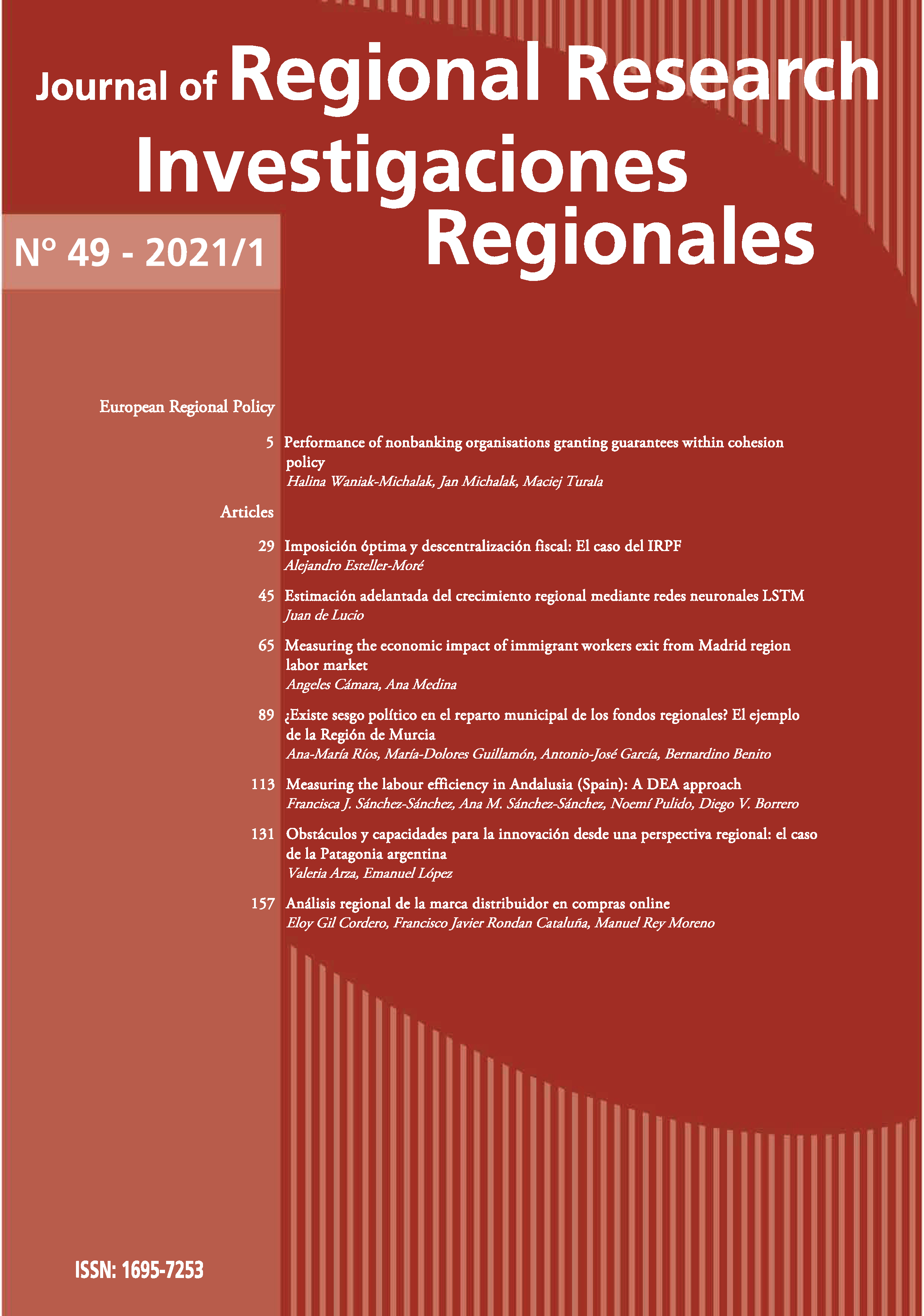Obstáculos y capacidades para la innovación desde una perspectiva regional: el caso de la Patagonia argentina
DOI:
https://doi.org/10.38191/iirr-jorr.21.004Resumen
Comparamos el efecto de obstáculos externos y capacidades internas de la firma sobre la innovación y la productividad, en la Patagonia versus resto del país para 2014-2016. Nuestra hipótesis es que el contexto regional incide en dichos efectos. Encontramos que en esa región los obstáculos externos afectan la decisión de inversión en innovación, como sucede a nivel nacional, pero además su intensidad. Las capacidades internas son más bajas que para el resto del país, pero tienen mayor incidencia para alentar la decisión de innovación. Estos hallazgos sugieren que la dimensión regional debe ser parte de la política de innovación.
Citas
Arza, V., & López, E. (2018). Obstacles to Innovation and Firm Size: A Quantitative Study for Argentina.: Competitiveness, Technology, and Innovation Division, Inter-American Development Bank. Technical Note Nº IDB-TN-1436.
Audretsch, D. B. (1997). Technological regimes, industrial demography and the evolution of industrial structures. Industrial and corporate change, 6(1), 49-82.
Blanchard, P., Huiban, J.-P., Musolesi, A., & Sevestre, P. (2013). Where there is a will, there is a way? Assessing the impact of obstacles to innovation. Industrial and Corporate Change, 22(3), 679-710.
Bond, S., Harhoff, D., & Van Reenen, J. (2003). Investment, R&D and financial constraints in Britain and Germany: Institute for Fiscal Studies London.
Cooke, P., Uranga, M. G., & Etxebarria, G. (1997). Regional innovation systems: Institutional and organisational dimensions. Research Policy, 26(4-5), 475-491.
Crescenzi, R., & Rodríguez‐Pose, A. (2013). R & D, Socio‐Economic Conditions, and Regional Innovation in the U. S. Growth and Change, 44(2), 287-320.
Galia, F., & Legros, D. (2004). Complementarities between obstacles to innovation: evidence from France. Research Policy, 33(8), 1185-1199.
Griliches, Z. (1979). Issues in Assessing the Contribution of Research and Development to Productivity Growth. The Bell Jorunal of Economics, 10(1), 92-116.
Iammarino S., Sanna-Randaccio F., Savona M. (2006) Obstacles to Innovation and Multinational Firms in the Italian Regions: Firm-level Evidence from the Third Community Innovation Survey. In: Tavares A.T.,
Teixeira A. (eds) Multinationals, Clusters and Innovation. Palgrave Macmillan, London
Jaramillo, H., Lugones, G., & Salazar, M. (2001). Normalización de Indicadores de Innovación Tecnológica en América Latina y el Caribe
MANUAL DE BOGOTÁ: Red Iberoamericana de Indicadores de Ciencia y Tecnología (RICYT) / Organización de Estados Americanos (OEA) / PROGRAMA CYTED COLCIENCIAS/OCYT.
Krugman, P. (1991). History and Industry Location: The Case of the Manufacturing Belt. American Economics Association Papers and Proceedings, 81, 80-83.
Lundvall, B.-Å. (1992). National systems of innovation : toward a theory of innovation and interactive learning. New York: Pinter Publishers.
Maldonado-Guzmán, G., Garza-Reyes, J. A., Pinzón-Castro, S. Y., & Kumar, V. (2017). Barriers to innovation in service SMEs: evidence from Mexico. Industrial Management & Data Systems, 117(8), 1669-1686.
Mancusi, M. L., & Vezzulli, A. (2010). R&D, innovation and liquidity constraints. Paper presented at the CONCORD 2010 Conference, Sevilla.
Marshall, A. (1961). Principles of Economics: An Introductory Volume, 9th (Variorum) ed. (1st ed., 1890). London: Macmillan
Nelson, R. (1995). Recent Evolutionary Theorizing about Economic Change. Journal of Economic Literature, 33, 48-90.
Nelson, R. R., & Winter, S. G. (1982). An evolutionary theory of economic change. Cambridge, Mass.: Belknap Press of Harvard University Press.
OECD. (1997). Proposed Guidelines for Collecting and Interpreting Technological Innovation Data.
OECD. (2005). Oslo Manual Guidelines for collecting and interpreting innovation data, third edition: OECD.
OECD/Eurostat. (2018). Oslo Manual 2018: Guidelines for Collecting, Reporting and Using Data on Innovation (4th Edition ed.). Paris/Eurostat, Luxembourg: OECD Publishing.
Pellegrino, G., & Savona, M. (2017). No money, no honey? Financial versus knowledge and demand constraints on innovation. Research policy, 46(2), 510-521.
Romer, P. M. (1990). Endogenous Technological Change. Journal of Political Economy, 98(5), 71-102.
Savignac, F. (2008). Impact of financial constraints on innovation: What can be learned from a direct measure? Economics of Innovation and New Technology, 17(6), 553-569.
Schwab, K. (2018) The Global Competitiveness Report 2018, World Economic Forum
Descargas
Publicado
Número
Sección
Licencia
Aquellos autores/as que tengan publicaciones con esta revista, aceptan los términos siguientes:
En el momento de aceptar la publicación de sus artículos en Investigaciones Regionales / Journal of Regional Research, los autores acceden a utilizar la licencia Creative Commons CC BY-NC. IIRR/JRR es una revista abierta que permite a los autores retener el máximo control sobre su trabajo. Los autores aceptarán utilizar la licencia Creative Commons Attribution-NonCommercial. Esta licencia permite a cualquier persona copiar y distribuir el artículo con propósitos no comerciales, siempre y cuando se atribuya adecuadamente la atribución del trabajo a la revista y a los autores.

